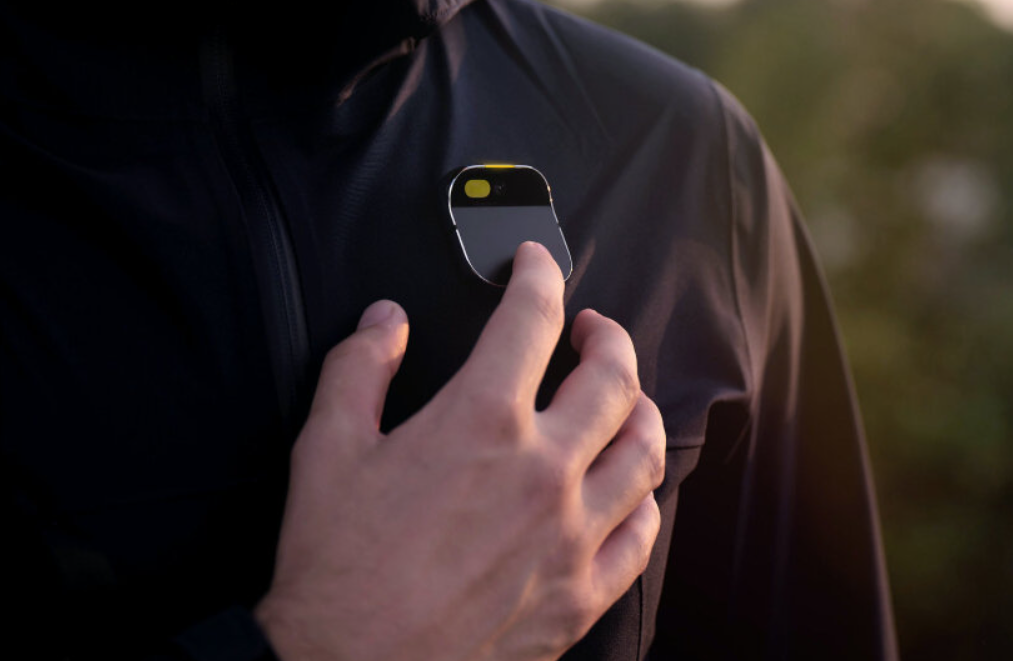For months, an intriguing sight has captivated the curiosity of a San Francisco police officer stationed outside the downtown offices of the tech startup, Humane. Employees regularly emerged from the building, each adorned with a small, square device pinned to their chests, resembling the officer’s bulkier body-worn camera. The mysterious gadget, known as the Ai Pin, was the talk of the town.
Today, the secrecy surrounding Humane’s innovative device has been unveiled. The company is finally opening up about the high-tech device designed to be fastened to a shirt or blouse, aiming to become as ubiquitous among the general public as wireless earbuds or smartwatches.
The Ai Pin, set to go on sale in the US on November 16, boasts an array of features. It can capture photos, send texts, project a visual interface onto the user’s palm using a laser, and comes equipped with a virtual assistant on par with ChatGPT. The goal is to reduce our dependency on smartphones by offering a constant companion for web searches and communication.
The device’s design, resembling a brooch or a small accessory, sets it apart from the more conspicuous wearables on the market. Its housing, carved from a single piece of aluminum, exudes a sense of elegance and sophistication. However, its conspicuous appearance might make it a conversation starter for those who sport it.
To attach the Ai Pin, users place a magnetic battery pack on the inside of their clothing, securing it with a magnet on the Pin itself. Weighing in at just 55 grams, or 2 ounces, it’s remarkably lightweight. Still, users with pacemakers should consult with their doctors about potential magnetic interference.
The Pin comes in three color options, primarily black with silver accents and one white option. Customers can purchase additional colorful plastic cases, known as “shields,” which not only add flair but also enhance durability, protecting the device from accidental drops.
One of the Pin’s most distinctive features is the curved top, housing an ultrawide camera, light and depth detectors, and a laser projector. The curvature ensures the camera points correctly and is not blocked by varying body shapes. This design lesson was learned from past experiences, such as Google Clips, which struggled to capture the intended subjects due to an inability to account for bodies with different shapes.
One of the Pin’s standout features is its privacy focus. A “trust light” indicates when the microphone or camera is active, and any tampering would render the device inoperative, making it immune to misuse.
Controlling the Pin is done through taps, hand gestures, and voice commands. A double-tap with two fingers on the front touchpad takes photos, and the same gesture followed by a hold captures video (expected in an upcoming software update in early 2024).
The Pin’s laser projector allows it to display images and text on the user’s palm. Users can navigate and select options by tilting their hand and swatting gestures. The voice assistant, named Ai Mic, can answer a wide range of questions, perform language translations, and even curate music playlists.
The Pin runs on Google’s open-source Android operating system, with customizations by Humane to enhance user experience. This makes it more accessible for developers to create apps for the device.
While the Ai Pin represents an exciting leap in wearable technology, questions remain about its acceptance and societal impact. Can a device like this truly encourage users to live more in the moment, or will it merely offer a new way to be obsessed with technology?
Humane’s founders, Bethany Bongiorno and Imran Chaudhri, remain optimistic, viewing the Ai Pin as the world’s first “contextual computer.” They believe it has the potential to revolutionize the way we interact with technology, touching people from various backgrounds and age groups. With a strong emphasis on privacy and transparency, Humane aims to differentiate itself from previous wearable devices.
The future of the Ai Pin is still uncertain, but its innovative approach to wearable technology opens the door to new possibilities and challenges the boundaries of our relationship with AI and gadgets. As it hits the market, it’s a device that will undoubtedly spark conversations and curiosity about the role of technology in our lives.
(Source: TechCrunch | Wired | Bloomberg)









